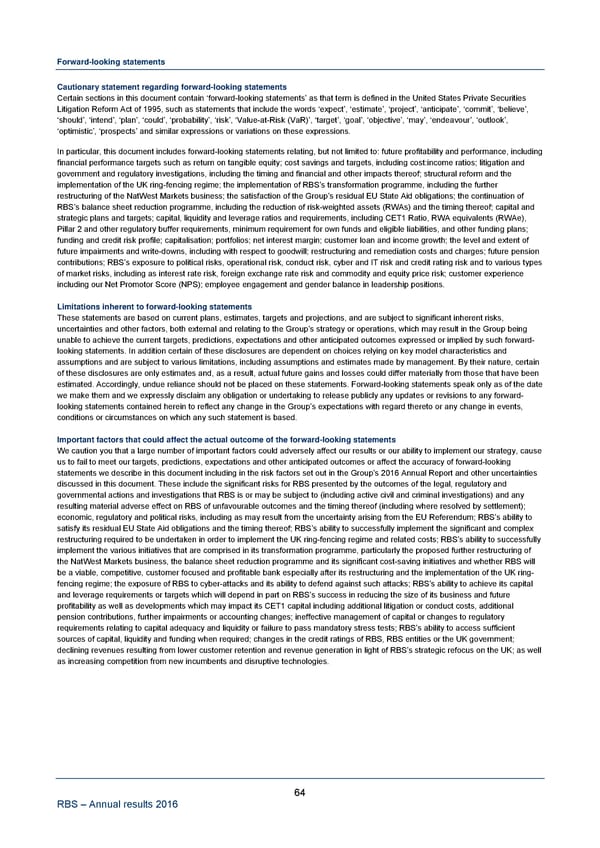Forward-looking statements Cautionary statement regarding forward-looking statements Certain sections in this document contain ‘forward-looking statements’ as that term is defined in the United States Private Securities Litigation Reform Act of 1995, such as statements that include the words ‘expect’, ‘estimate’, ‘project’, ‘anticipate’, ‘commit’, ‘believe’, ‘should’, ‘intend’, ‘plan’, ‘could’, ‘probability’, ‘risk’, ‘Value-at-Risk (VaR)’, ‘target’, ‘goal’, ‘objective’, ‘may’, ‘endeavour’, ‘outlook’, ‘optimistic’, ‘prospects’ and similar expressions or variations on these expressions. In particular, this document includes forward-looking statements relating, but not limited to: future profitability and performance, including financial performance targets such as return on tangible equity; cost savings and targets, including cost:income ratios; litigation and government and regulatory investigations, including the timing and financial and other impacts thereof; structural reform and the implementation of the UK ring-fencing regime; the implementation of RBS’s transformation programme, including the further restructuring of the NatWest Markets business; the satisfaction of the Group’s residual EU State Aid obligations; the continuation of RBS’s balance sheet reduction programme, including the reduction of risk-weighted assets (RWAs) and the timing thereof; capital and strategic plans and targets; capital, liquidity and leverage ratios and requirements, including CET1 Ratio, RWA equivalents (RWAe), Pillar 2 and other regulatory buffer requirements, minimum requirement for own funds and eligible liabilities, and other funding plans; funding and credit risk profile; capitalisation; portfolios; net interest margin; customer loan and income growth; the level and extent of future impairments and write-downs, including with respect to goodwill; restructuring and remediation costs and charges; future pension contributions; RBS’s exposure to political risks, operational risk, conduct risk, cyber and IT risk and credit rating risk and to various types of market risks, including as interest rate risk, foreign exchange rate risk and commodity and equity price risk; customer experience including our Net Promotor Score (NPS); employee engagement and gender balance in leadership positions. Limitations inherent to forward-looking statements These statements are based on current plans, estimates, targets and projections, and are subject to significant inherent risks, uncertainties and other factors, both external and relating to the Group’s strategy or operations, which may result in the Group being unable to achieve the current targets, predictions, expectations and other anticipated outcomes expressed or implied by such forward- looking statements. In addition certain of these disclosures are dependent on choices relying on key model characteristics and assumptions and are subject to various limitations, including assumptions and estimates made by management. By their nature, certain of these disclosures are only estimates and, as a result, actual future gains and losses could differ materially from those that have been estimated. Accordingly, undue reliance should not be placed on these statements. Forward-looking statements speak only as of the date we make them and we expressly disclaim any obligation or undertaking to release publicly any updates or revisions to any forward- looking statements contained herein to reflect any change in the Group’s expectations with regard thereto or any change in events, conditions or circumstances on which any such statement is based. Important factors that could affect the actual outcome of the forward-looking statements We caution you that a large number of important factors could adversely affect our results or our ability to implement our strategy, cause us to fail to meet our targets, predictions, expectations and other anticipated outcomes or affect the accuracy of forward-looking statements we describe in this document including in the risk factors set out in the Group’s 2016 Annual Report and other uncertainties discussed in this document. These include the significant risks for RBS presented by the outcomes of the legal, regulatory and governmental actions and investigations that RBS is or may be subject to (including active civil and criminal investigations) and any resulting material adverse effect on RBS of unfavourable outcomes and the timing thereof (including where resolved by settlement); economic, regulatory and political risks, including as may result from the uncertainty arising from the EU Referendum; RBS’s ability to satisfy its residual EU State Aid obligations and the timing thereof; RBS’s ability to successfully implement the significant and complex restructuring required to be undertaken in order to implement the UK ring-fencing regime and related costs; RBS’s ability to successfully implement the various initiatives that are comprised in its transformation programme, particularly the proposed further restructuring of the NatWest Markets business, the balance sheet reduction programme and its significant cost-saving initiatives and whether RBS will be a viable, competitive, customer focused and profitable bank especially after its restructuring and the implementation of the UK ring- fencing regime; the exposure of RBS to cyber-attacks and its ability to defend against such attacks; RBS’s ability to achieve its capital and leverage requirements or targets which will depend in part on RBS’s success in reducing the size of its business and future profitability as well as developments which may impact its CET1 capital including additional litigation or conduct costs, additional pension contributions, further impairments or accounting changes; ineffective management of capital or changes to regulatory requirements relating to capital adequacy and liquidity or failure to pass mandatory stress tests; RBS’s ability to access sufficient sources of capital, liquidity and funding when required; changes in the credit ratings of RBS, RBS entities or the UK government; declining revenues resulting from lower customer retention and revenue generation in light of RBS’s strategic refocus on the UK; as well as increasing competition from new incumbents and disruptive technologies. 64 RBS – Annual results 2016
 Annual Results Announcement Page 72 Page 74
Annual Results Announcement Page 72 Page 74